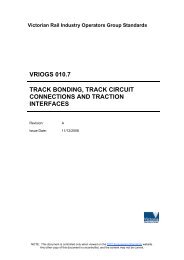VRIOGS 002.1 Railway Station Design Standard and Guidelines
VRIOGS 002.1 Railway Station Design Standard and Guidelines
VRIOGS 002.1 Railway Station Design Standard and Guidelines
Create successful ePaper yourself
Turn your PDF publications into a flip-book with our unique Google optimized e-Paper software.
<strong>VRIOGS</strong> <strong>002.1</strong> Revision A 33Figure 3: An example of a DDA compliant ramp for a 7.1m overpass8.5.3 Stairs <strong>and</strong> L<strong>and</strong>ingsStairs are a quick <strong>and</strong> efficient option for able bodies; however they are not permitted as asole means of access under the DSAPT 10 . DSAPT compliant ramps or lifts, or both shallbe provided as an alternative. It is essential that stairs are designed so that they are safefor both regular circulation <strong>and</strong> emergency egress. In circumstances where there isinsufficient space for ramps, the compact nature of allows them to be placed in moreconstricted spaces.The pedestrian flow rate on stairs is considerably less than other modes. As outlined inAppendix A, the pedestrian flow rate on stairs based on a service level of E is 49pedestrians per metre per minute. As such, when stairs are constricted in width they arenot suited for large volumes <strong>and</strong> are often associated with blockages if used at peak oremergency times. Ramps are better suited to h<strong>and</strong>ling large peak volumes.It has been established that stairs with a clear line of sight are much safer for commutersthan those which are tiered or have turning points on their l<strong>and</strong>ings. A straight stairwaysignificantly reduces accidents that occur as a result of the directional change which cancause cramming <strong>and</strong> conflicting travel paths. A clear line of sight on stairs also reducesthe occurrence of blind spots which create a security risk.Stairs should be designed to the following requirements:a) The designer is to exercise their judgement in evaluating the traffic patterns <strong>and</strong>peaking characteristics to achieve a flow rate of 26 passengers per minute (Fruinlevel C). See Appendix A for more detail;b) Stairs should be designed to provide protection from the weather;c) Stair flights shall:i. If used as a means of entering/leaving a platform, shall run in the samedirection as the platform length;ii.iii.Not include winding, curved <strong>and</strong> spiral configurations;Provide an equal or as close as possible to, number of treads for each stairflight.d) Stair widths shall:i. Accommodate normal passenger movement in two directions;10 DSAPT Clause 14 StairsNOTE: This document is controlled only when viewed on the DOT Engineering <strong>St<strong>and</strong>ard</strong>s website. Any othercopy of this document is uncontrolled, <strong>and</strong> the content may be inaccurate.

















